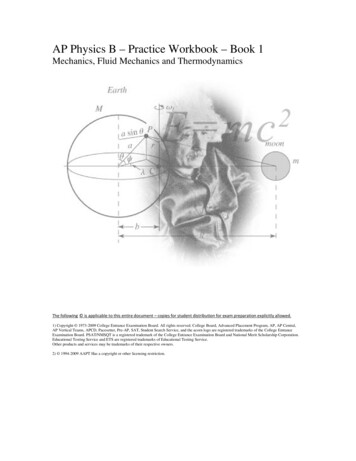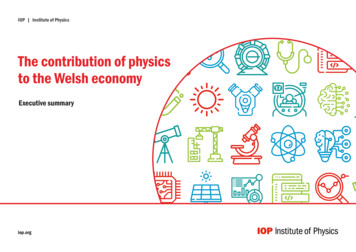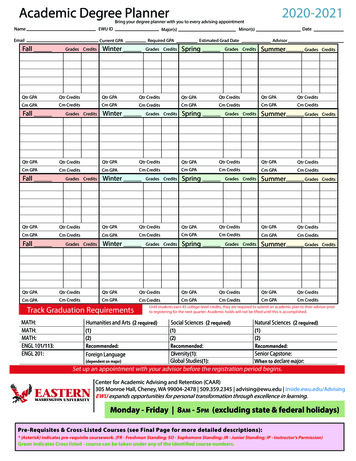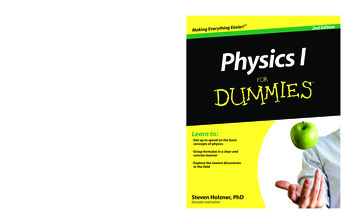
Transcription
This book is provided FREE withtest registration by theGraduate Record Examinations Board.Graduate Record Examinations This practice bookcontains one actual full-lengthGRE Physics Test test-taking strategiesBecome familiar with test structure and content test instructions andanswering proceduresCompare your practicetest results with theperformance of thosewho took the test at aGRE administration.PHYSICSTESTPRACTICEBOOKVisit GRE Online atwww.gre.org
Note to Test Takers: Keep this practice book until you receive your score report.The book contains important information about content specifications and scoring.Copyright 2001 by Educational Testing Service. All rights reserved.EDUCATIONAL TESTING SERVICE, ETS, the ETS logos, GRADUATE RECORD EXAMINATIONS,and GRE are registered trademarks of Educational Testing Service.
Table of ContentsPurpose of the GRE Subject Tests . 3Development of the Subject Tests. 3Content of the Physics Test . 4Preparing for a Subject Test. 5Test-Taking Strategies . 6What Your Scores Mean . 6Practice Physics Test . 9Scoring Your Subject Test . 73Evaluating Your Performance . 76Answer Sheet . 77Purpose of the GRESubject TestsThe GRE Subject Tests are designed to help graduateschool admission committees and fellowship sponsorsassess the qualifications of applicants in specific fieldsof study. The tests also provide you with an assessmentof your own qualifications.Scores on the tests are intended to indicate knowledge of the subject matter emphasized in many undergraduate programs as preparation for graduate study.Because past achievement is usually a good indicator offuture performance, the scores are helpful in predictingsuccess in graduate study. Because the tests are standardized, the test scores permit comparison of studentsfrom different institutions with different undergraduateprograms. For some Subject Tests, subscores are provided in addition to the total score; these subscoresindicate the strengths and weaknesses of your preparation, and they may help you plan future studies.The GRE Board recommends that scores on theSubject Tests be considered in conjunction with otherrelevant information about applicants. Because numerous factors influence success in graduate school,reliance on a single measure to predict success is notadvisable. Other indicators of competence typicallyinclude undergraduate transcripts showing coursestaken and grades earned, letters of recommendation,the GRE Writing Assessment score, and GRE GeneralTest scores. For information about the appropriate useof GRE scores, write to GRE Program, EducationalTesting Service, Mail Stop 57-L, Princeton, NJ 08541,or visit our Web site at www.gre.org/codelst.html.Development of theSubject TestsEach new edition of a Subject Test is developed by acommittee of examiners composed of professors in thesubject who are on undergraduate and graduate faculties in different types of institutions and in differentregions of the United States and Canada. In selectingmembers for each committee, the GRE Program seeksthe advice of the appropriate professional associationsin the subject.The content and scope of each test are specifiedand reviewed periodically by the committee of examiners. Test questions are written by the committee and byother faculty who are also subject-matter specialistsand by subject-matter specialists at ETS. All questionsproposed for the test are reviewed by the committeeand revised as necessary. The accepted questions areassembled into a test in accordance with the contentspecifications developed by the committee to ensureadequate coverage of the various aspects of the fieldand, at the same time, to prevent overemphasis on anysingle topic. The entire test is then reviewed andapproved by the committee.Subject-matter and measurement specialists on theETS staff assist the committee, providing informationand advice about methods of test construction andhelping to prepare the questions and assemble the test.In addition, each test question is reviewed to eliminatelanguage, symbols, or content considered potentiallyoffensive, inappropriate for major subgroups of the testtaking population, or likely to perpetuate any negativeattitude that may be conveyed to these subgroups. Thetest as a whole is also reviewed to ensure that the testquestions, where applicable, include an appropriatebalance of people in different groups and different roles.Because of the diversity of undergraduate curricula,it is not possible for a single test to cover all thematerial you may have studied. The examiners,PHYSICS TESTPRACTICE BOOK3
therefore, select questions that test the basic knowledge and skills most important for successful graduatestudy in the particular field. The committee keeps thetest up-to-date by regularly developing new editionsand revising existing editions. In this way, the testcontent changes steadily but gradually, much like mostcurricula. In addition, curriculum surveys are conducted periodically to ensure that the content of a testreflects what is currently being taught in the undergraduate curriculum.After a new edition of a Subject Test is first administered, examinees’ responses to each test question areanalyzed in a variety of ways to determine whethereach question functioned as expected. These analysesmay reveal that a question is ambiguous, requiresknowledge beyond the scope of the test, or is inappropriate for the total group or a particular subgroup ofexaminees taking the test. Answers to such questionsare not used in computing scores.Following this analysis, the new test edition isequated to an existing test edition. In the equatingprocess, statistical methods are used to assess thedifficulty of the new test. Then scores are adjusted sothat examinees who took a difficult edition of the testare not penalized, and examinees who took an easieredition of the test do not have an advantage. Variations in the number of questions in the differenteditions of the test are also taken into account inthis process.Scores on the Subject Tests are reported as threedigit scaled scores with the third digit always zero.The maximum possible range for all Subject Test totalscores is from 200 to 990. The actual range of scores fora particular Subject Test, however, may be smaller. Themaximum possible range of Subject Test subscores is20 to 99; however, the actual range of subscores for anytest or test edition may be smaller. Subject Test scoreinterpretive information is provided in Interpreting YourGRE Scores, which you will receive with your GREscore report, and on the GRE Web site at www.gre.org/codelst.html.Content of the Physics TestThe test consists of about 100 five-choice questions,some of which are grouped in sets and based on suchmaterials as diagrams, graphs, experimental data, anddescriptions of physical situations.4The aim of the test is to determine the extent ofthe examinees’ grasp of fundamental principles andtheir ability to apply these principles in the solutionof problems. Most test questions can be answered onthe basis of a mastery of the first three years of undergraduate physics.The International System (SI) of units is usedpredominantly in the test. A table of information (seepage 10) representing various physical constants and afew conversion factors among SI units is presented inthe test book.The approximate percentages of the test on themajor content topics have been set by the committeeof examiners, with input from a nationwide survey ofundergraduate physics curricula. The percentagesreflect the committee’s determination of the relativeemphasis placed on each topic in a typical undergraduate program. These percentages are given below alongwith the major subtopics included in each contentcategory. In each category, the subtopics are listedroughly in order of decreasing importance for inclusionin the test. Nearly all the questions in the test willrelate to material in this listing; however, there may beoccasional questions on other topics not explicitlylisted here.1. CLASSICAL MECHANICS (such askinematics, Newton’s laws, work andenergy, oscillatory motion, rotationalmotion about a fixed axis, dynamics ofsystems of particles, central forces andcelestial mechanics, three-dimensionalparticle dynamics, Lagrangian andHamiltonian formalism, noninertialreference frames, elementary topics influid dynamics)20%2. ELECTROMAGNETISM (such aselectrostatics, currents and DCcircuits, magnetic fields in free space,Lorentz force, induction, Maxwell’sequations and their applications,electromagnetic waves, AC circuits,magnetic and electric fields in matter)18%3. OPTICS AND WAVE PHENOMENA (such as wave properties, superposition, interference, diffraction,geometrical optics, polarization,Doppler effect)9%PHYSICS TESTPRACTICE BOOK
4. THERMODYNAMICS AND STATISTICAL MECHANICS (such asthe laws of thermodynamics, thermodynamic processes, equations of state,ideal gases, kinetic theory, ensembles,statistical concepts and calculation ofthermodynamic quantities, thermalexpansion and heat transfer)10%5. QUANTUM MECHANICS (such asfundamental concepts, solutions ofthe Schrödinger equation (includingsquare wells, harmonic oscillators,and hydrogenic atoms), spin, angularmomentum, wave function symmetry,elementary perturbation theory)12%6. ATOMIC PHYSICS (such as properties of electrons, Bohr model, energyquantization, atomic structure, atomicspectra, selection rules, black-bodyradiation, x-rays, atoms in electric andmagnetic fields)10%7. SPECIAL RELATIVITY (such asintroductory concepts, time dilation,length contraction, simultaneity,energy and momentum, four-vectorsand Lorentz transformation,velocity addition)6%8. LABORATORY METHODS (such asdata and error analysis, electronics,instrumentation, radiation detection,counting statistics, interaction ofcharged particles with matter, lasersand optical interferometers, dimensional analysis, fundamental applications of probability and statistics)6%9. SPECIALIZED TOPICS: Nuclearand Particle physics (e.g., nuclearproperties, radioactive decay, fissionand fusion, reactions, fundamentalproperties of elementary particles),Condensed Matter (e.g., crystalstructure, x-ray diffraction, thermalproperties, electron theory of metals,semiconductors, superconductors),9%Miscellaneous (e.g., astrophysics, mathematical methods, computer applications)Those taking the test should be familiar withcertain mathematical methods and their applicationsin physics. Such mathematical methods include singleand multivariate calculus, coordinate systems (rectangular, cylindrical, and spherical), vector algebra andvector differential operators, Fourier series, partialdifferential equations, boundary value problems,matrices and determinants, and functions of complexvariables. These methods may appear in the test in thecontext of various content categories as well as occasional questions concerning only mathematics in thespecialized topics category above.Preparing for a Subject TestGRE Subject Test questions are designed to measureskills and knowledge gained over a long period of time.Although you might increase your scores to someextent through preparation a few weeks or monthsbefore you take the test, last-minute cramming isunlikely to be of further help. The following information may be helpful. A general review of your college courses isprobably the best preparation for the test. However, the test covers a broad range of subjectmatter, and no one is expected to be familiarwith the content of every question. Use this practice book to become familiarwith the types of questions in the GRE PhysicsTest, paying special attention to the directions. Ifyou thoroughly understand the directions beforeyou take the test, you will have more time duringthe test to focus on the questions themselves.PHYSICS TESTPRACTICE BOOK5
Test-Taking StrategiesWhat Your Scores MeanThe questions in the practice test in this book illustrate the types of multiple-choice questions in the test.When you take the test, you will mark your answers ona separate machine-scorable answer sheet. Total testingtime is two hours and fifty minutes; there are noseparately timed sections. Following are some generaltest-taking strategies you may want to consider.Your raw score — that is, the number of questions youanswered correctly minus one-fourth of the numberyou answered incorrectly — is converted to the scaledscore that is reported. This conversion ensures that ascaled score reported for any edition of a Subject Testis comparable to the same scaled score earned on anyother edition of the same test. Thus, equal scaledscores on a particular Subject Test indicate essentiallyequal levels of performance regardless of the testedition taken. Test scores should be compared onlywith other scores on the same Subject Test. (Forexample, a 680 on the Computer Science Test is notequivalent to a 680 on the Mathematics Test.)Before taking the test, you may find it useful toknow approximately what raw scores would be requiredto obtain a certain scaled score. Several factors influence the conversion of your raw score to your scaledscore, such as the difficulty of the test edition and thenumber of test questions included in the computationof your raw score. Based on recent editions of thePhysics Test, the table on the next page gives the rangeof raw scores associated with selected scaled scores forthree different test editions. (Note that when thenumber of scored questions for a given test is greaterthan the range of possible scaled scores, it is likely thattwo or more raw scores will convert to the same scaledscore.) The three test editions in the table that followswere selected to reflect varying degrees of difficulty.Examinees should note that future test editions may besomewhat more or less difficult than the test editionsillustrated in the table. Read the test directions carefully, and work asrapidly as you can without being careless. Foreach question, choose the best answer from theavailable options. All questions are of equal value; do not wastetime pondering individual questions you findextremely difficult or unfamiliar. You may want to work through the test quiterapidly, first answering only the questions aboutwhich you feel confident, then going back andanswering questions that require more thought,and concluding with the most difficult questionsif there is time. If you decide to change an answer, make sure youcompletely erase it and fill in the oval corresponding to your desired answer. Questions for which you mark no answer or morethan one answer are not counted in scoring. As a correction for haphazard guessing, onefourth of the number of questions you answerincorrectly is subtracted from the number ofquestions you answer correctly. It is improbablethat mere guessing will improve your scoresignificantly; it may even lower your score.If, however, you are not certain of the correctanswer but have some knowledge of the questionand are able to eliminate one or more of theanswer choices, your chance of getting the rightanswer is improved, and it may be to your advantage to answer the question. Record all answers on your answer sheet.Answers recorded in your test book will notbe counted. Do not wait until the last five minutes of atesting session to record answers on youranswer sheet.6PHYSICS TESTPRACTICE BOOK
Range of Raw Scores* Needed to EarnSelected Scaled Scores on ThreePhysics Test Editions ThatDiffer in DifficultyRaw ScoresScaled ScoreForm AForm BForm umber of Questions Used to Compute Raw Score10010098*Raw Score Number of correct answers minus one-fourth thenumber of incorrect answers, rounded to the nearest integerFor a particular test edition, there are many ways toearn the same raw score. For example, on the editionlisted above as “Form A,” a raw score of 47 would earna scaled score of 700. Below are a few of the possibleways in which a scaled score of 700 could be earned onthat edition.Examples of Ways to Earna Scaled Score of 700 on theEdition Labeled As “Form A”QuestionsAnsweredRaw Score Correctly474747524757Number ofQuestions Questions Questions UsedAnsweredNotto ComputeIncorrectly Answered Raw Score0531002028100403100PHYSICS TESTPRACTICE BOOK7
Practice TestTo become familiar with how the administration will be conducted at the test center, first remove theanswer sheet (pages 77 and 78). Then go to the back cover of the test book (page 72) and follow theinstructions for completing the identification areas of the answer sheet. When you are ready to begin thetest, note the time and begin marking your answers on the answer sheet.8PHYSICS TESTPRACTICE BOOK
FORM GR96779
10
This test starts on page 12.11
12
SCRATCHWORK13
14
SCRATCHWORK15
16
SCRATCHWORK17
18
SCRATCHWORK19
20
SCRATCHWORK21
22
SCRATCHWORK23
24
SCRATCHWORK25
26
SCRATCHWORK27
28
SCRATCHWORK29
30
SCRATCHWORK31
32
SCRATCHWORK33
34
SCRATCHWORK35
36
SCRATCHWORK37
38
SCRATCHWORK39
40
SCRATCHWORK41
drAConductoryVacuum42x
SCRATCHWORK43
44
SCRATCHWORK45
46
SCRATCHWORK47
48
SCRATCHWORK49
50
SCRATCHWORK51
52
SCRATCHWORK53
54
SCRATCHWORK55
56
SCRATCHWORK57
58
SCRATCHWORK59
THIS ITEM WAS NOT SCORED.60
SCRATCHWORK61
62
SCRATCHWORK63
64
SCRATCHWORK65
66
SCRATCHWORK67
68
SCRATCHWORK69
70
SCRATCHWORK71
72
Scoring Your Subject TestPhysics Test scores typically range from 400 to 990.The range for different editions of a given test mayvary because different editions are not of preciselythe same difficulty. The differences in ranges amongdifferent editions of a given test, however, usually aresmall. This should be taken into account, especiallywhen comparing two very high scores. The scoreconversion table on page 75 shows the score rangefor this edition of the test only.The worksheet on page 74 lists the correct answersto the questions. Columns are provided for you to markwhether you chose the correct (C) answer or anincorrect (I) answer to each question. Draw a lineacross any question you omitted, because it is notcounted in the scoring. At the bottom of the page,enter the total number correct and the total numberincorrect. Divide the total incorrect by 4 and subtractthe resulting number from the total correct. This is theadjustment made for guessing. Then round the result tothe nearest whole number. This will give you your rawtotal score. Use the total score conversion table to findthe scaled total score that corresponds to your rawtotal score.Example: Suppose you chose the correct answers to44 questions and incorrect answers to 30. Dividing 30by 4 yields 7.5. Subtracting 7.5 from 44 equals 36.5,which is rounded to 37. The raw score of 37 corresponds to a scaled score of 740.PHYSICS TESTPRACTICE BOOK73
Worksheet for the Physics Test, Form GR9677Answer Key and Percentage* of ExamineesAnswering Each Question CorrectlyQUESTIONNumber AnswerP TOTALCIQUESTIONNumber AnswerP rrect (C)Incorrect (I)Total Score:C – I/4 Scaled Score (SS) * TheP column indicates the percentage of Physics Test examinees thatanswered each question correctly; it is based on a sample of December 1996examinees selected to represent all Physics Test examinees tested betweenOctober 1, 1993, and September 30, 1996.** Item 90 was not scored when this form of the test was originally administered.74PHYSICS TESTPRACTICE BOOK
Score Conversions and Percents Below*for GRE Physics Test, Form GR9677TOTAL SCORERaw ScoreScaled Score%Raw ScoreScaled 4804704604504401197643*Percentage scoring below the scaled score is based on the performance of11,322 examinees who took the Physics Test between October 1, 1993, andSeptember 30, 1996.PHYSICS TESTPRACTICE BOOK75
Evaluating Your PerformanceNow that you have scored your test, you may wish tocompare your performance with the performance ofothers who took this test. Both the worksheet on page74 and the table on page 75 use performance data fromGRE Physics Test examinees.The data in the worksheet on page 74 are based onthe performance of a sample of the examinees who tookthis test in December 1996. This sample was selected torepresent the total population of GRE Physics Testexaminees tested between October 1993 and September1996. The numbers in the column labeled “P ” on theworksheet indicate the percentages of examinees in thissample who answered the questions correctly. You mayuse these numbers as a guide for evaluating your performance on individual test questions.The table on page 75 contains, for each scaledscore, the percentage of examinees tested betweenOctober 1993 and September 1996 who received lowerscores. Interpretive data based on the scores earned byexaminees tested in this three-year period were used byadmissions officers in the 1997-98 testing year. Thesepercentages appear in the score conversion table in acolumn to the right of the scaled scores. For example,in the percentage column opposite the scaled score of660 is the number 53. This means that 53 percent ofthe GRE Physics Test examinees tested betweenOctober 1993 and September 1996 scored lower than660. To compare yourself with this population, look atthe percentage next to the scaled score you earned on76the practice test. Note: due to changes in the test-takingpopulation, the percentile rank data have also changed.To obtain current percentile rank information, visit theGRE Web site at www.gre.org/codelst.html, or contactthe GRE Program.It is important to realize that the conditions underwhich you tested yourself were not exactly the same asthose you will encounter at a test center. It is impossible to predict how different test-taking conditionswill affect test performance, and this is only one factorthat may account for differences between your practicetest scores and your actual test scores. By comparingyour performance on this practice test with the performance of other GRE Physics Test examinees, however,you will be able to determine your strengths andweaknesses and can then plan a program of study toprepare yourself for taking the GRE Physics Test understandard conditions.PHYSICS TESTPRACTICE BOOK
54082-007627 U81M9 Printed in U.S.A.IN 991067
The maximum possible range for all Subject Test total scores is from 200 to 990. The actual range of scores for a particular Subject Test, however, may be smaller. The maximum possible range of Subject Test subscores is 20 to 99; however, the actual range of subscores for any test or test edition may be smaller. Subject Test score











